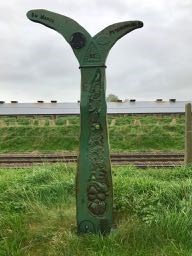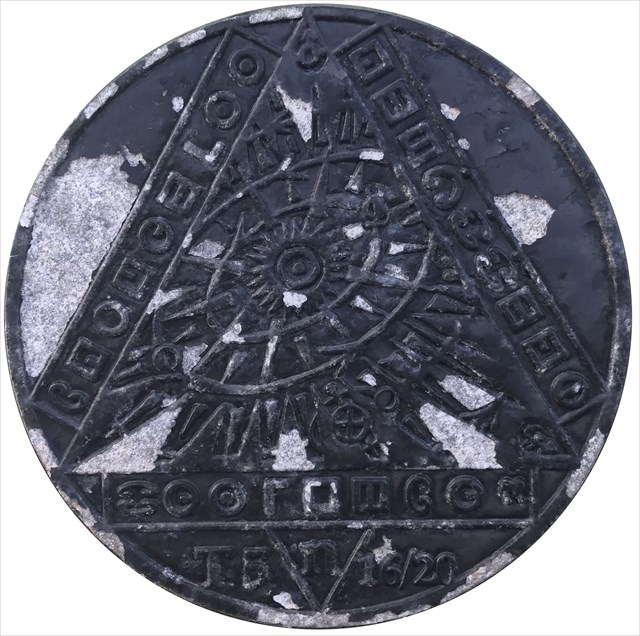The Millennium Time Trail was a fascinating project developed by Sustrans to celebrate the year 2000 Millennium and promote Sustainable Transport through the National Cycle Network.
Unfortunately, in less than two decades since the project was launched it has been all but forgotten, even by Sustrans. Much of the original material has been lost and few people now remember the aims of the project or what the remaining posts and plaques represent.
Sponsored by the Royal Bank of Scotland, 1,000 marker posts were commissioned, in four basic designs. These were to be positioned around the country’s National Cycle Network. These posts were each to carry a circular plaque - game pieces in the Millennium Time Trail. A total of 50 different disks were designed for the main part of the trail and ten different disks in a supplemental ‘Rare Disk’ series. People were to be encouraged to collect rubbings of each one to earn special Time Souvenirs from Sustrans. As the marker posts were to be distributed around the whole country ti would be difficult for any person to visit every marker post so the country was divided into nine regions and each region would contain at least two of each disk in the entire set. It would therefore be possible to ‘collect’ the entire set within a single region.
The disks are collected into five different ‘series’:
- T1 – set of four – “The Seasons”
- 2. T2 – set of six – “The Continents”
- 3. T3 – set of eight – “The Ages of Man”
- 4. T4 – set of twelve – “The Signs of the Zodiac”
- 5. T5 – set of twenty – “The Centuries”
There is also an additional series of ‘Rare’ disks (I believe this contains ten different designs, but I may be wrong) which contain clues to solve additional elements of the puzzle.
Each disk carries an image relating to the theme of the series. This image is surrounded by a segment of a poem written in cipher based on St. Thomas More’s Utopian alphabet. The entire poem (shown below) is divided amongst the fifty disks in the main five series.
Although records are incomplete, Sustrans have stated that they believe that only one person ever completed the entire quest.

The post at this location is a design “Fossil Tree” by John Mills. The post takes the form of an abstract tree, inspired by Sigillaria, an extinct tree-like plant with a tall, occasionally forked trunk, whose fossils are commonly found in Carboniferous deposits (about 270 million years ago). The post features imagery of fossils depicting the passage of time from early primitive creatures to the ultimate demise of fossil fuel driven technology.

The disk carried by this post is from series T5 (The centuries). This series comprises of twenty disks, each representing one of the centuries in the millennium being celebrated. This is disk 16 of 20, representing the sixteenth century.
In the Centre of the image is a stylised sun. At the top right of this is the symbol for Mercury (☿), and at the opposite side is Venus (♀). Down at the bottom is an alternate symbol for Earth (⊕), with the Moon orbiting it.
The image appears to represent the Copernican view of the universe with the sun at the centre of the universe and the planets circling around it. Copernicus published this model in the sixteenth century (1543), refuting the Ptolemaic view with Earth at centre and all other bodies following complicated paths around us. It is usually viewed as the start of modern astronomy and the beginnings of the scientific revolution.
The cipher around the image represents the fragment of the Time Trail poem shown in red below. The entire poem is divided up amongst all the fifty disks in the first five series.
MEASURE EVERY HEARTBEAT TO COUNT OUT OUR LIFE’S SCORE
IS “TIME TO ESCAPE” MEANT TO FIRE OUR COMING AGE?
LOCKED IN SEASONS’ BARS SWINGS PENDULUM’S CEASELESS CLAY
LUNGS NEVER FULL ENSNARE US IN TIME’S EIGHT PIECE CAGE
ENTROPY’S AIM SHOOTS LEPTONS IN DANCING CYCLES OF LIGHT
NATIONS REACH OUT IN HOPE ACROSS TIME ZONES AND LONG DEGREES
NO CORNERS TO HIDE US, EARTH’S SHADE SPINS HOURLY ROUND TONIGHT
IN ALL MIND-STREAMS WE WADE, OUR WORLD-LINES WEAVE PAST TAPESTRIES
UNCERTAIN DREAMS EVOLVE IN THE STRUGGLE FOR THE “WHY?”
MUST IN ALL THESE TIDES OF FAITH, FLOW STILL SUCH WAVES OF FEARS?
PLACE AND TIME TEMPT FATES, BUT ALL LIFE’S NATURE IS TO DIE
OUR ERA, STARS, BOWS OUT, PLAYING ITS MUSICAL SPHERES
EVERY GAINED UTOPIAN GOAL MAKES US MANIFOLD TIME’S TREASURE
MAPPED OUT, AS ABOVE SO BELOW, NERGAL TICKS OFF TIME’S MEASURE